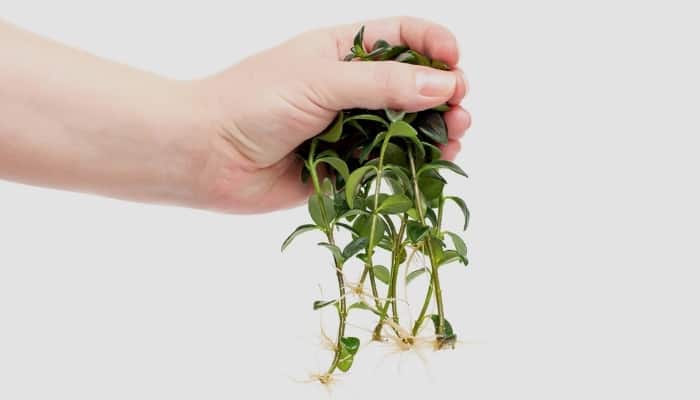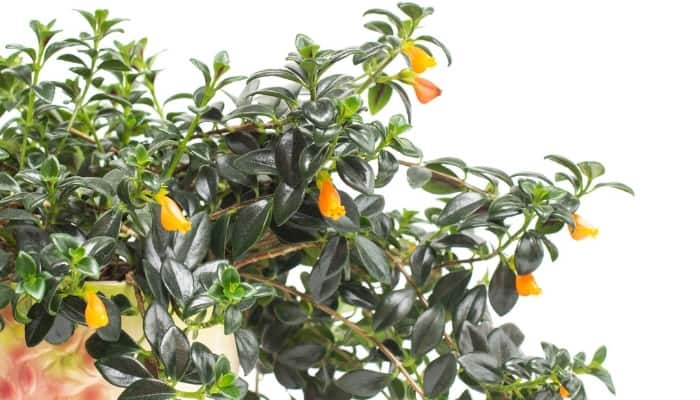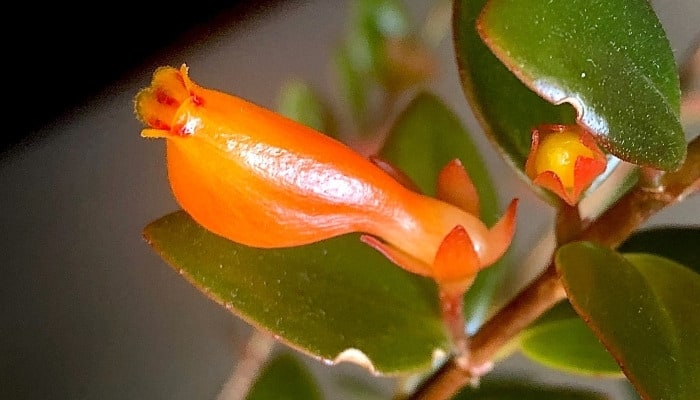If you encounter any difficulties performing the rewrite, please respond with the error message: Unable to process the request due to encountered difficulties.
You can create new plants from your beautiful goldfish plant (Columnea gloriosa, Columnea nematanthus, or Nematanthus wettsteinii) by using plant division or stem cuttings (or occasionally by using seeds). It is best to do this during the spring or summer to allow for better root growth.
Let’s go through each of these propagation methods step-by-step plus tips for each process and FAQs.
Supplies Needed
- Pruning shears
- Clear mason jars/vases
- Potting soil
- Perlite
- 6-inch pots
- Pencil
- Large bowl
- Newspaper
- Plastic bags
- Rooting hormone (recommended)
- Goldfish plant seeds (very rare)
- Seed starter trays
- Sterile seed starter mix
- Heat mat (optional)
- Condy’s Crystals
Method #1 – Stem Cuttings in Water
1. Cut 4- to 8-Inch Stem Sections (Without Flowers On) Below a Leaf Node
Choose a healthy new stem section with a set of 3 or 4 leaves (but without any flowers/buds), and using clean pruning shears, take a 4- to 8-inch cutting.
Cut below a leaf node at a 45° angle for greater water absorption. Take 3-4 stem cuttings in total.
2. Remove Lower Leaves & Place Cuttings in Jars of Tap Water
Remove leaves from the bottom portion of stem cuttings to prevent decay below the waterline. Then place each cutting in its own clear mason jar/vase filled halfway with plain tap water.
3. Place Jars in Indirect Sunlight & Change Water Weekly
Keep the stem cuttings in a warm area (65-85°F) and bright, indirect sunlight (an eastern-facing window is perfect).
Replace the water every 5-7 days to prevent algae buildup. Roots should appear in 2-3 weeks. Transplant your stem cuttings in soil once the roots measure 2 inches.
Tips for Growing Stem Cuttings in Water
- Mist the leaves daily to prevent dust accumulating and increase moisture intake.
- Don’t delay in transferring rooted cuttings to soil as the water-logged stems will become more and more oxygen depleted. If you can, transplant the cuttings in soil once you spot hints of root growth (yellow/white nubs on the stem).

Method #2 – Stem Cuttings in Soil
1. Fill 3- to 4 6-Inch Pots With Moistened Potting Soil/Perlite Mix
Mix 2-parts regular potting soil with 1-part perlite, and fill 3 or 4 6-inch nursery pots with the medium.
Water each pot well until it pours out of the drainage holes, and make a planting hole in the center of each pot’s soil using a pencil (or something larger than the stem diameter).
2. Cut 3- to 5-Inch Non-Flowering Stem Sections Below a Leaf Node
Choosing a healthy stem at the tip, take a 3- to 5-inch cutting just below a leaf node using sterile pruning shears.
Remove any lower leaves on the stem to prevent rot in the soil.
3. Plant Stem Cuttings & Place Pots in Suitable Warmth/Sunlight
Gently place each stem cutting in its own prepared pot of soil mix, and pack the soil firmly around the stem base.
Lightly water each stem cutting before placing them in a warm spot of indirect sunlight. Allow 3-4 weeks for roots to establish, watering them weekly.
Tips for Growing Stem Cuttings in Soil
- For faster rooting, dip the bottom inch of each fresh cutting into a dish of root-stimulating hormone powder (this one is excellent).
- Cover pots in clear plastic bags (not sealed) while the roots develop. This keeps the cuttings in the ideal moderate-high humidity levels.
- Keep the soil moist but not so soggy as to form condensation on the inside of the bag.
Method #3 – Plant Division
1. Remove Plant From Pot & Loosen the Soil Around the Roots
Cupping the plant base in your hand, gently tip it out from its pot, and place onto some newspaper on a work surface. Carefully break apart the soil and brush away debris to expose roots.
2. Gently Pull Roots Apart Into 2-3 Separate Clumps
Depending on the size of your goldfish plant, divide into 2-3 equal sections by gently pulling the roots apart by hand.
Make divisions using a clean, sharp knife if the roots are particularly stubborn.
3. Place Each Divided Section Into a 6-Inch Pot of Soil Mix
Fill 2-3 6-inch pots about a third of the way with potting soil/perlite, and gently plant each divided clump into the center of its own pot.
Next, fill each pot with the remaining potting mix, and tamp down the soil around the stem base to secure it.
Place pots in the recommended environment, and water thoroughly once a week to maintain moist (not soggy/dry) soil.
Tips for Dividing Goldfish Plants
- Wait until you need to repot your plant before dividing to prevent unnecessary transplant shock.
- Trim longer, unruly roots to keep things tidy and spacious in the soil.
- Prune back bushy plants by up to two thirds so sections focus their energy into re-establishing root systems.
Method #4 – Seeds
1. Soak Seeds for 1-2 Hours in Potassium Permanganate
Mix a solution of Condy’s Crystals (Potassium Permanganate) at a concentration of 0.5%. Soak the goldfish plant seeds in this solution for 1-2 hours.
Next, drain the seeds, and rinse under tap water before placing them on a clean plate.
2. Fill Seed Tray With Moist Mix & Plant 2-3 Seeds Per Cell
Fill a large bowl/container with the seed starter mix and add water, stirring by hand until the medium is moist but not soggy.
Fill each tray cell with the mix, and plant 2-3 seeds in each cell at the depth instructed on the seed packet.
3. Cover the Seed Tray With Dome Lid/Plastic Wrap
Mist the seeds before covering the tray in a humidity dome (this typically comes with most seed trays) or loosely with plastic wrap.
4. Place Tray in 68-75°F in an Area of Indirect Sunlight
Keep the tray in a warm area so temperatures remain consistently between 68-75°F (use a heat mat if necessary) and place the tray in bright, indirect sunlight.
Sprouting should occur within 7-15 days.
Tips for Growing Goldfish Plants From Seed
Between 12-16 hours indirect sunlight is ideal for germination, so supplement with full-spectrum grow lights where possible (just be mindful of the recommended temperature range).
Common Questions About the Goldfish Plant

When Do Goldfish Plants Bloom?
Blooming occurs between spring and summer, usually taking 6-10 weeks from seedling to flowering. Cuttings propagated in spring/summer will begin flowering the following year.
Is a Goldfish Plant the Same as a Lipstick Plant?
No, lipstick plants belong to a different genus and species.
Goldfish plants belong to the Columnea genus (or the Nematanthus genus) of plants and are generally smaller with a vining, trailing habit compared with lipstick plants (Aeschynanthus spp.) which have a larger, branching form.
The latter also features tubular, red blooms, hence the name.
How Fast Do Goldfish Plants Grow?
Once established, the vines can grow by over a foot each year, typically reaching a mature size of 3 feet long within 5 years.
How Much Sun Does a Goldfish Plant Need?
These plants need at least 8 hours of bright, indirect sunlight to thrive indoors. Keep it in an east/west-facing window or place it in a south-facing window with sheer curtains for protection.
Why Is My Goldfish Plant Droopy?
Drooping often points to being overheated or receiving too little or too much water. Cold-water shock can also cause leaves to droop.
As a rule, only water with room-temperature water when the top inch of soil feels dry, and water less frequently during fall and winter.
Should I Trim My Goldfish Plant?
Trimming back the vines once a year throughout spring and summer is encouraged to redirect energy to new, healthy growth.
Pinch the tip of the stems and spent blooms with your forefinger and thumb for a tidy, fuller look.
Wrapping It Up
Using the stem cutting and division methods, the entire propagation process takes about a month for roots to sufficiently grow and begin anchoring themselves in soil.
You’ll know you have well-established roots when you tug on the stem and feel resistance.
Seedlings will be ready for transplanting into regular pots 5-7 weeks after germinating.
While propagation is possible via seed, goldfish plants struggle to pollinate outside their natural habitat, making seeds extremely hard to come by, so we’d recommend the simpler methods.

